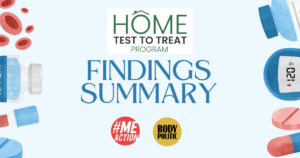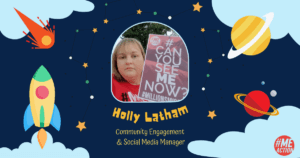NINDS, the National Institute for Neurological Disorder and Stroke at the NIH has solicited an RFI, or a Request for Information, from the ME community on how to advance research for myalgic encephalomyelitis.
With only a few weeks’ turn-around, the #MEAction NIH working group met and was able to produce a compelling response based on past work that was produced with broad input and consensus, including the letter to Frances Collins signed by over 7,000 community stakeholders, the meeting with and presentation to Francis Collins at the end of 2018, and #MEAction’s survey to solicit community input for the 2016 RFI that received over 1800 responses; you can see the results of that work here: Part 1, Part 2, and Part 3.
#MEAction’s current RFI response is also based on long-standing and well-known issues within the community documented by wide range of advocates, scientists, clinicians and stakeholders: in NIH’s 2011 State of Knowledge Workshop report, NIH’s 2015 Pathways to Prevention report, the 2015 National Academy of Medicine report, CFS Advisory Committee recommendations since 2003, and numerous reports and recommendations by patient advocacy organizations over decades. The NIH has failed to act on these recommendations, and continues to demand answers of a patient community that still has the same, unmet needs.
[maxbutton id=”17″ url=”http://www.meaction.net/wp-content/uploads/2019/04/NANDS-RFI-Response_MEAction-Public-Draft_04242019.pdf” text=”Read our draft response” ]
The overarching and most compelling research need in ME/CFS is to deliver tangible outcomes for people with ME: diagnostics and treatments. With the right plan and political will, it should be possible to deliver one or more clinically viable ME biomarkers within 3 years and at least one FDA-approved symptomatic or disease-modifying treatment within 5 years.
However, NIH’s current approach is to plant seeds with small funds and to hope they grow. This is an ineffective strategy, in which there are never enough resources for such gradual growth to occur. Instead, people with ME find themselves in much the same situation, year after year.
Despite the short notice, we strongly encourage people with ME and other stakeholders to:
1) Meet with us for a phone call this Friday at 5pm ET / 2pm PT to discuss the RFI process and address questions. Register here.
2) Provide #MEAction input on items 8 and 9 to be incorporated into the RFI response:
- Approaches to reduce barriers that prevent individuals with ME/CFS from participating in research. For example, these might be logistical challenges, such as difficulty traveling to a study site, or might be because of an unwillingness to undergo certain types of research protocols.
- Strategies for increasing ME/CFS research collaboration and communication between relevant stakeholders.
Submit your responses to these two questions to #MEAction by clicking here.
3) We also encourage you to submit your own RFI response to cover any gaps you may note in our drafted response. You can submit your own response to the NINDS RFI here.
[maxbutton id=”17″ url=”http://www.meaction.net/wp-content/uploads/2019/04/NANDS-RFI-Response_MEAction-Public-Draft_04242019.pdf” text=”Read our draft response” ]We are proud of the #MEAction NIH Working Group’s efforts to provide a such a comprehensive and incisive report. It’s ambitious while clearly laying out a plan to grow the field of ME research in a sustainable and collaborative way.
Please join me in thanking everyone who worked so hard on this!







1 thought on “#MEAction Drafts Response to NIH’s Request for Information”
I’m trying to email this page to myself so that I can print it out at a public computer (I don’t have a printer), to be able to read it more easily (the computer hurts my eyes), but all it forwards is a blank page. Can you help? Thanks. I’m signed up on your website.
Comments are closed.